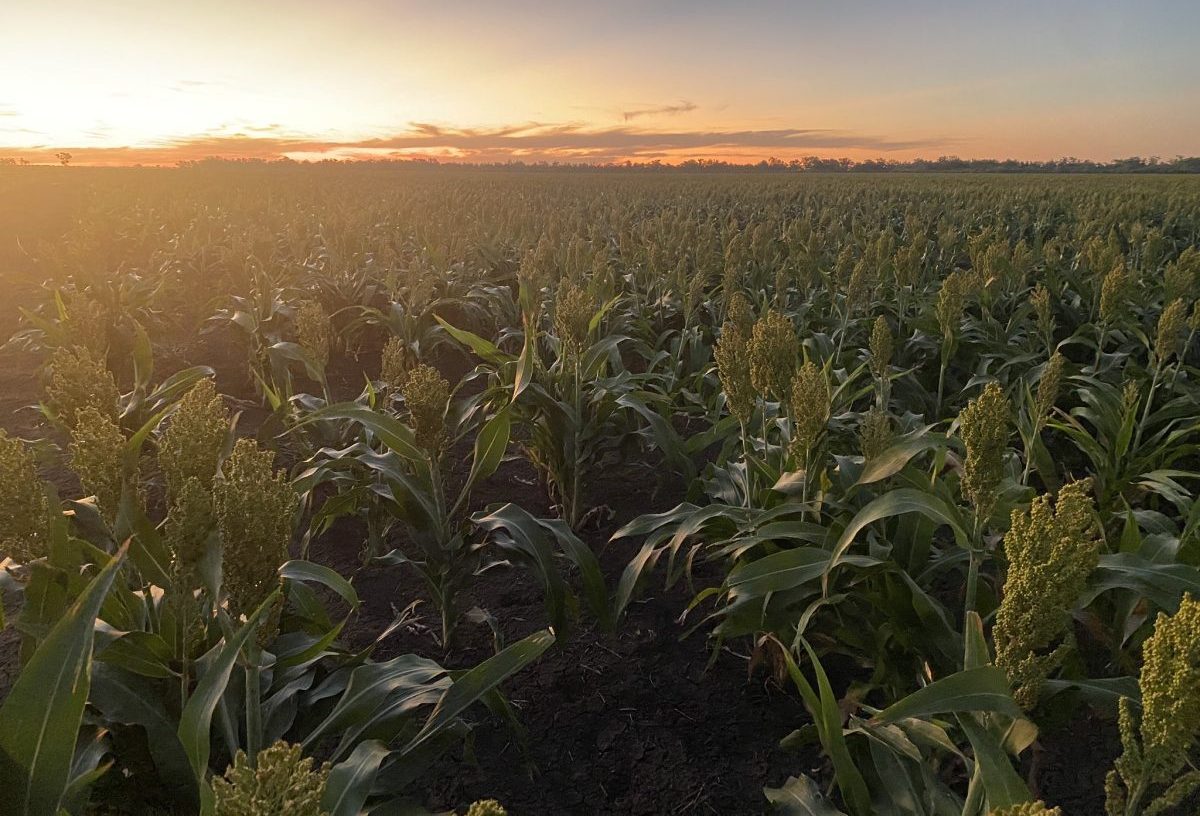
A sorghum crop at Come-by-Chance in NSW after rain on Monday and due to be harvested next month. Photo: Market Check
PRICES for feedgrain have firmed in the past week across eastern Australia on some short covering of white grain, and as the northern freight market remains firmly focused on getting sorghum to port.
Limited selling from growers of warehoused and on-farm wheat and barley has also allowed prices to drift higher as they turn their attention to planting oats and dual-purpose canola to kick off their winter-crop seeding programs.
Export demand for wheat remains buoyant, and feedlots are booking barley in reasonable amounts, mostly on offer from the trade.
| Today | Mar 9 | |
| Barley Downs | $415 | $408 |
| SFW wheat Downs | $415 | $410 |
| Sorghum Downs | $430 | $425 |
| Barley Melbourne | $370 | $365 |
| ASW Melbourne | $425 | $420 |
| SFW Melbourne | $420 | $418 |
Table 1: Indicative prices in Australian dollars per tonne.
North gets rain
While some districts received no rain, storms brought some big falls in the week to 9am today.
Despite interrupting the desiccation and harvest of some sorghum crops, the rain has been welcome ahead of winter-crop planting which will start in earnest next month.
In Central Queensland, registrations include: Capella 46mm; Clermont 40mm; Emerald 60mm, and Springsure 53mm.
In southern Qld, totals include: Dalby 71mm; Jondaryan 57mm; Macalister 90mm; Miles 145mm; Roma 37mm; Surat 73mm.
Rain in central and northern New South Wales was patchier, and totals include: Gunnedah 94mm; Moree 67mm; Mungindi 22mm; Narrabri 45mm; Parkes 59mm; and 24-73mm in Condobolin gauges.
Sorghum harvesting is continuing at pace, and the red grain is making its way at pace to Newcastle and Brisbane in containers and in bulk ready for shipment to China.
One trader said new business on wheat and barley has been this as a result.
“The focus is getting sorghum off, and there’s not a lot of wheat and barley being offered up,” one trader said.
Carriers are booked up carting sorghum, and wheat to consumers has become tricky to fit into freight schedules, a situation unlikely to change for another month or so as the sorghum task continues.
“I think they’re still chasing wheat.”
At Gunnedah, Quest Commodities managing directorJayne Barker said the rain will be beneficial for late-maturing sorghum on the Liverpool Plains, where harvest is starting and will run through to early May.
“The ports are setting the pace on price, and packers are trying to compete,” Ms Barker said.
Up country, barley is priced at evens to a $10/t discount to wheat, and Ms Barker said the spread on wheat grades is only around $20/t between SFW and H2.
I don’t see a helluva lot left of durum in depots, a fair bit of bread wheat sold.
“We saw growers kept the strategy of selling lower grades to start with, and now we’re seeing some growers pull the trigger on the H2s.”
“We’ve seen quite a bit of selling of wheat in the past month as people were just trying to get rid of it ahead of sorghum; from April on, it’s going to be tight.”
Activity has ramped in the durum space, with at least two vessels booked to load out of Newcastle in coming weeks, and one already gone.
“Once they arrive at destination, and the buyers feel comfortable with quality, there’s potential for another.”
Most of the Liverpool Plains’ durum has been warehoused, and could make its way into the domestic stockfeed market if volume is insufficient to pull together a fourth cargo.
Shorts lift south
Growers in southern NSW and Victoria are preparing to make a start on planting dual-purpose and grazing crops following rain which fell mostly on the south-west slopes of NSW.
Registrations for the week to 9am today include: Cootamundra 57mm; Temora 113mm, and Young 76mm.
Planting of cash crops normally starts from Anzac Day onward, and Peters Commodities trader Peter Gerhardy said the market for wheat and barley has firmed this week, despite the Bureau of Meteorology sending out an El Nino Watch.
“The job’s firmed up a bit in the last couple of days in wheat and barley markets,” Mr Gerhardy said.
“The consumer seems comfortable, but the trade might have a short here or there.”
While there is no shortage of trucks to carry grain to port or feed mills, Mr Gerhardy said the market was conscious of a switch in grower mind-set often seen at this time of year as they turn attention to getting the winter crop in the ground.
“Some growers don’t want to see a truck on their farm in April and May when they’re planting.”
Rail line update
Following last week’s collision between an empty grain train and a truck west of Junee, Transport for NSW has advised the Junee-Narrandera rail line in southern NSW will open on or around March 27.
“UGL Regional Linx (UGLRL), the operator and maintainer of the Country Regional Network on behalf of Transport for NSW, has advised that the freight-train operator is expected to start recovering the derailed train starting with wagons on Friday, 17 March 2023, subject to the ground conditions being dry enough for large cranes,” a Transport for NSW spokesperson said.
“Once the track is cleared, UGLRL can complete a full track inspection and commence remediation works.
“It is currently anticipated that the line will re-open on or around Monday, 27 March 2023, weather permitting.”
The line’s closure has impacted freight and passenger services, although freight from Narrandera can access the Melbourne-Sydney line by going on the longer route via Yenda and Stockinbingal.
Grain Central: Get our free news straight to your inbox – Click here

HAVE YOUR SAY